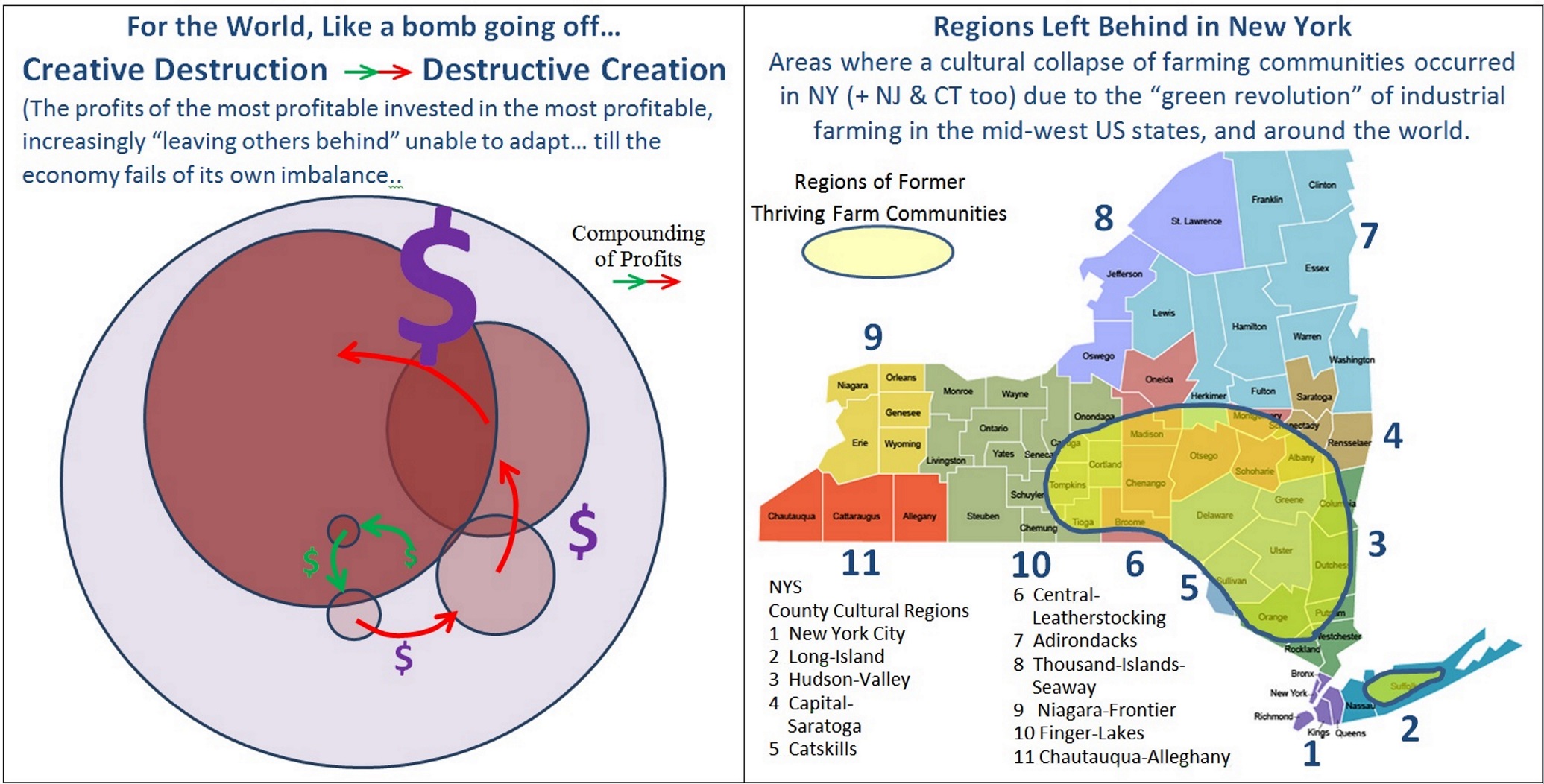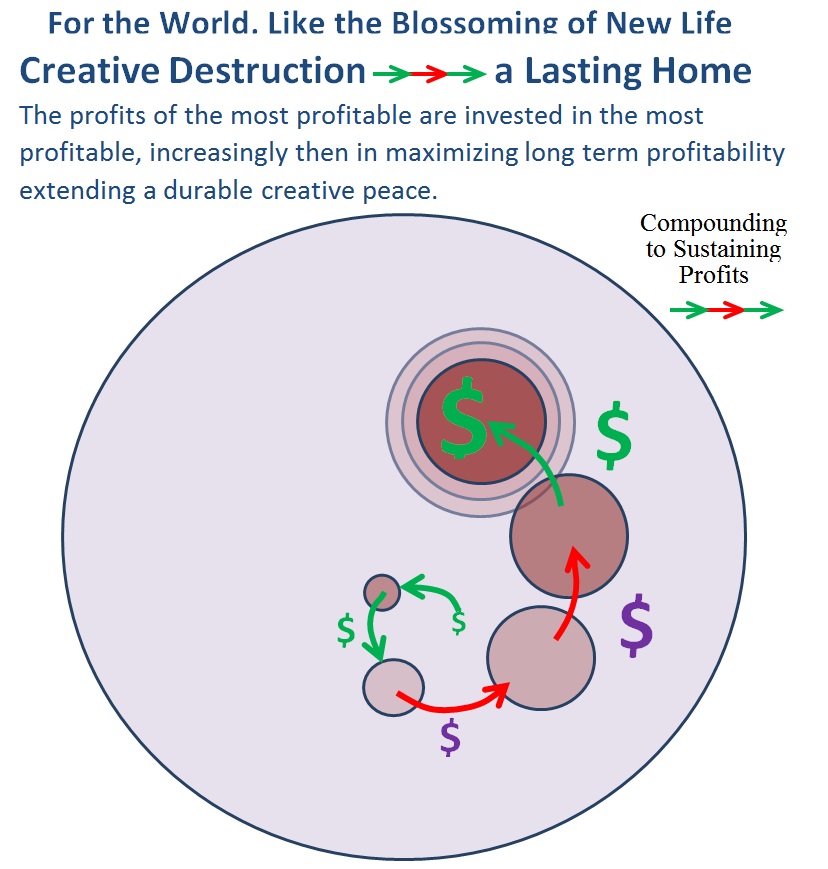The discussion of the UN’s Sustainable development Goals (SDG’s) focuses on the poor, and “Leaving No One Behind”. That overlooks that it’s most often the growth of the world economy that made older parts of the economy outmoded, and leaving whole communities behind as the world economy moves on to what’s more profitable. This discussion illustrates more of the detail, how innovative change like the “green revolution” thought to be for feeding the poor. It would quite predictably also leave more and more agricultural communities behind, …as everyone has increasingly seen in their own regions… like in my own home region of New York State, exhibiting common symptoms of being economically left behind you see around the world:
- abandonment of rural communities
- as farmers can’t afford sell to feed their own communities
- the flight to cities with now skills to sell
- the growing refugee and landless migrant populations
- growing youth cultures with little to do but to get angry
- or that are fighting over resources degraded by over use
And that’s only one of the kinds of distressed communities unable to keep up with the competition ans the most profitable invest their profits in becoming more profitable and more and more people can’t keep up.

These all actively leave whole societies of suffering people behind in a way that is not reversible. It’s the real predictability of ever escalating competition causing all these uncounted impacts of how we invest money in growth for the wealthy, that undermining the sustainability traditional economies. That’s the real quandary here, it so very predictable. What DO development planners think about, not to ask who the latest innovation will put out of business. Well, to do real sustainable design, we’d need to add that question to the list, what will our “killer app” put out of business? It’s always a trade-off when you “create jobs” of any kind, that there will be jobs lost elsewhere with a very high probability.
Conceptually the lasting profitability option is fairly simple, gradual stabilizing of the whole system profit as the profitability of growth stops growing as fast, leading to a steady state creative living.

________________
For the big picture of how we got the math wrong…
The economic impacts we don’t count turn out to be the great majority of disruptive earth and societal impacts we experience (seeImpactsUncounted ). They even have a name, the “externalities” incurred as liabilities of obtaining services by paying someone else to deliver the goods. So those are actually internal to the operating necessities for running a business, only external to the accounting we’ve been doing. Counting them is actually just ruled out for SD accounting, by a “stroke of a pen”, as effects that decision makers don’t feel responsible for, and have no direct control over. Those include impacts of financial decisions, for investing in disruptive innovations, also excluded from the discussion of impacts by the stroke of a pen.
Some impacts of finance are easily measured and some not, so to fully understand the problem takes sorting through what is accountable and what is not, develop different ways of assigning shares of responsibility. Certainly the ones that are measurable should be counted. They’re mostly counted globally, like soil and water depletion and lots of other things. They’re just not at present assigned to anyone’s responsibility. Doing so proportional to share of world GDP would be both scientifically correct and perfectly fair. So a study group would pick one or two such questions at a time to see what can be learned.
Another concern is how the continual compounding of profits forces everyone in the economy struggle to keep up with financial demands for ever increasing productivity and competition… what the phrase “the rat race” technically refers to. It’s why we all seem forced to to run ever faster to stay in one place. That’s of course not really sustainable, but very hard to know how to measure. Still, it’s a very real kind of suffering and accumulative culture change, and connected to the escalating competition in the economy that leaves ever more people and communities behind, a kind of “destructive creation”.
In figures 1 & 2 illustrate how regions are left behind, using the example of how once thriving agricultural communities of New York State collapsed, leaving long term economic damage behind. The question is where did the money go that once invested in productive farming in the region. The costs were left behind as the money fled to create the extractive industrial farming of the mid-west and elsewhere, mining water and fossil fuel resources very unsustainably, to grow corn, wheat and soy where it wouldn’t thrive naturally. Of course, much of this is only observable in hind sight and not really manageable, but the costs to society clearly also do escalate. That makes it imperative we take responsibility and do what’s right. The driver is making more profits, for investing in even more competitive businesses, using “disruptive innovation” that also leavea ever more others behind somewhere too.
For many decades people have more often called that effect of disruptive innovations “creative destruction”, accepting that to make more money and increase the economy’s products, you have to destroy the economy’s old ways of making products. The hard question is when to change from calling that “creative destruction” to calling it “destructive creation”. The programming of the economy to always grow that process seems to assure ever stiffer competition for everyone, all the time. It’s so constant we might just take it for granted,… but as a continual culture change for pushing everyone to face ever stiffer competition for how they live, it’s certainly not sustainable. As you push the limits then… it seems to naturally leave more and more people and environments behind, and be really more destructive than productive.
How that escalates is illustrated below, alongside the map of New York State, roughly showing the area of Central NY farming communities that vanished in the 50’s to 70’s, giving in to the competition from industrial farming. We could count the region’s lasting economic and cultural damages, perhaps. We can also see that the global corollary is of larger scale and seeming leaving more and more behind around the globe all the time. We can see it was no one’s political decision, nor is there anyone else at direct fault. We can see that kind of change is quite irreversible once it has happened. We’d only know if we counted it, and attributed the costs to our financial decisions to profit that way. As societal collapses are not reversible, we’d really need a more holistic way of measuring our impacts, to understand the costs of how we make money for our future.
